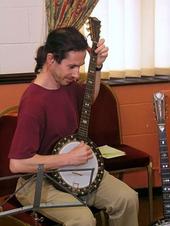(Photo by Nick Bamber)
Bujogo ngopata player Joaquim Cabritan.
Soga Island, Guinea Bissau, 8/06
I'm a classic-style banjoist who's been playing since the age of twelve. After twelve years living in Finland and Estonia, I moved back to my home town, Manchester (UK), where I now earn a living teaching banjo and woodwind. I'm also studying to become a piano tuner.
I co-run zither-banjo.org , a website dedicated to that variant of the 5-string banjo. The zither-banjo was developed by classic banjoist Alfred D. Cammeyer (1862-1949) of Brooklyn, NY. He introduced the zither-banjo into Britain in 1888 and it soon became one of the most popular forms of the banjo over here. I'm currently gathering material for a biography of the great British banjoist Olly Oakley (1876-1943).
Recently, I've been working with fellow "banjologists" from Europe and America tracing the banjo's roots in West Africa . These include my friends Swedish banjo historian Ulf Jägfors , Gambian Jola scholar/musician Daniel Laemouahuma Jatta , American old-time musician/scholar Ben Nelson , and American folk musician/researcher Shlomo Pestcoe , to name but a few.
Since 2005, I've also travelled to Senegal, Gambia, and Guinea Bissau to conduct field research into the folk lute traditions of various peoples, such as the Jola ekonting and the Bujogo (Bijago) ngopata . The sound clips in my MP3 are excerpts of field recordings I made of traditional musicians playing these instruments.
(Photo by Nick Bamber)
Jola musician Bouba Diedhiou playing the entofen form
of the ekonting folk lute. Casamance, Senegal, 2005.
FIELD RESEARCH IN WEST AFRICA
Like many banjoists I've had a longstanding curiosity as to the true origins of the banjo. Early 2005 I began to plan a visit to West Africa, partly to find out about the people and way of life there, and partly to find out more about local ethnic musical traditions. Then, by chance, I found articles by Ulf Jägfors and Daniel Jatta about the ekonting the folk lute of the Jola people of Senegal, Gambia and Guinea Bissau.
During my two month visit to Senegal in 2005 I was lucky enough to get to know lots of Jola, stay in Jola villages in Casamance (southern Senegal)-- the heartland of Jola culture and the birthplace of the ekonting -- and hear at close range a number of ekonting players singing and playing.
It is hard to describe my first experiences of hearing an ekonting . My reaction was simply, Its a banjo!
I decided to return to West Africa in 2006 to visit my friends and make further exploration. I timed this visit to coincide with the opening of The Akonting Center in Gambia and the first-ever international conference in West Africa on the African roots of the banjo . My first fortnight in Senegambia was spent with Jola friends in Dakar. After The Akonting Center's inaugural festivities, I then revisited the Jola villages of Youtou and Mlomp where I had spent such a happy time last year eating mangoes, listening to the ekonting, and learning about Jola culture. These villages are very beautiful places and a perfect panacea for anyone tired of Western urban life.
Nick, American banjoist Rhiannon Giddens , and friends from Si Jamboukan, a traditional Jola music and dance performance troupe from Casamance (southern Senegal), in Mandinary, Gambia for the opening of The Akonting Center for Senegambian Folk Music in July 2006. Si Jamboukan features a dance group made up of young Jola girls from the Casamance village of Mlomp, many of whom you see here. (Photo by Greg Addams )
Ulf Jägfors had reported on a trip into neighbouring Guinea Bissau where he had heard music played on the bunchundo, a gourd lute played by the Manjak people that's akin to the Jola ekonting . There were also other similar instruments, which we knew of but had not yet found, which were played by neighbouring ethnic groups such as the Balanta and Pepel. I imagined that in addition to this there could also be yet further instruments that none of us had yet heard of. I decided on the spur of the moment to set off for the Bijago Islands off the Guinea Bissau coast. There live the Balanta, as well as the native inhabitants of the islands, the Bujogo. I got my visa for Guinea Bissau and set off with a Jola friend from Youtou. There we came across two lutes that were unknown outside of the Bijago Islands-- the Bujogo ngopata and the Balanta kusunde.
For more information and photos of the these instruments, please read my articles: